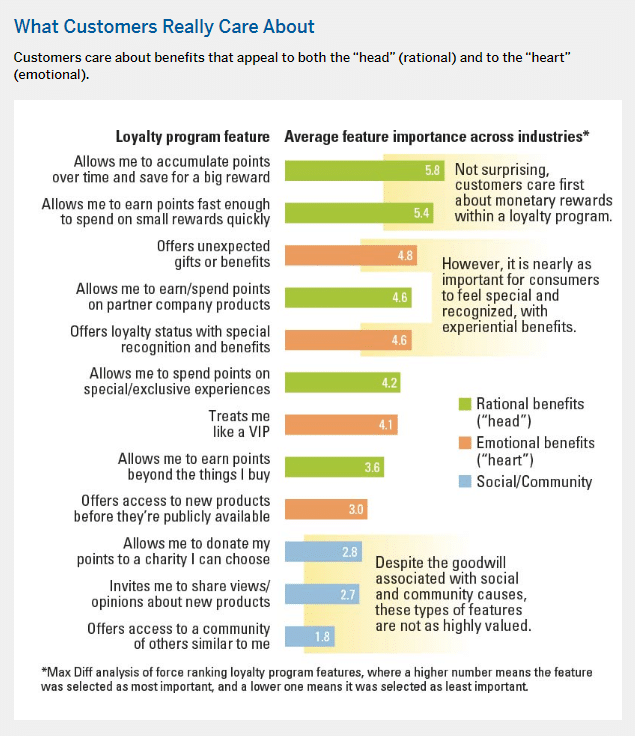Why build a restaurant loyalty program?
Offering a loyalty program helps advance your business by strengthening existing relationships with patrons and encouraging more frequent visits from first-time or occasional diners.
In an age, where the charm and excitement of traditional dining are being replaced by fast-paced, homogenous, and transactional characteristics—there is a greater need now than ever, to reaffirm guests of your passion towards creating experiences that are emotional, memorable, and individual.
Incentivizing guests in a way that genuinely recognizes and appreciates their business can lead to stronger brand loyalty and grow your restaurant’s share of their total dine-out budget.
According to a study conducted by Deloitte, that observed restaurant patron’s affinity towards loyalty programs and the impact it has on their purchase behavior—87% of diners make use of loyalty programs at their favored restaurants, and 82% of those that do, use them more than any other restaurant loyalty program.
It should be considered a vital component of your restaurant brand marketing strategy, because when created with data-driven insights a loyalty program allows your restaurant to cut through the clutter and establish a competitive brand differentiation within your vertical.
It offers a platform to boost brand visibility in ways that advertising can’t. More compellingly, a loyalty program that is relevant to your diners has great potential to motivate brand ambassadors and passionate foodies alike to amplify your reach through positive reviews.
Restaurant loyalty programs also have the added advantage of revealing how responsive your guests are towards the products and services you sell. This is because building a loyalty program that’s effective in your restaurant setting must go together with a deep understanding of how your customers choose to dine and engage with your restaurant.
The first step to serving guests in this fashion is knowing who they are (more on this below). This may seem daunting but building out a repository of guest information—including name, email, phone, and potentially key dates—can start small and grow incrementally. It’s possible that you already have the tools to start at your disposal, such as a database in your point of sale system, a website, or other systems that can accommodate such a program.
Why doesn’t every restaurant have loyalty rewards then?
Although it’s become an increasingly important aspect that sways diner behavior, it’s surprising that this trend hasn’t been met with a stronger response from the restaurant industry.
According to research conducted by the National Restaurant Association, only about one-third of quick service, fine dining, casual dining, family dining, and fast-casual restaurants institute loyalty programs.

It’s not explicitly clear why the percentages are so low, given the myriad of benefits they propose, but what is clear is that these low rates indicate a gap in the industry, that we believe presents a ripe opportunity for restaurants to take advantage of.
How do you build a restaurant loyalty program that works?
- Keep it simple
- Establish who your core customers are
- Reward meaningfully, but also creatively
- Promote your restaurant loyalty program consistently across different channels
It shouldn’t take your guests more than 90 seconds to register for your loyalty program once they understand how they stand to benefit from it. Keep in mind, the goal of having a loyalty program is to capture guest attention and cultivate a stronger preference for what your restaurant can offer them, in terms of a holistic experience.
You stand to be more successful in doing so if you can communicate the rewards for their loyalty by respecting their time and effort required to sign up. A simple loyalty program is also easier to measure, in terms of ROI for your business, and provides your staff with the ease in advocating for them.
The blueprint of an effective scalable loyalty program should identify who the patrons or regulars of your restaurant are. These are individuals that are already sold on what you have to offer and are most likely to take advantage and appreciate loyalty benefits.
The intension of your program should be to encourage brand affinity and repeat business for all your guests, but the first step in that direction begins with those that favor you today. If you can’t motivate them to register, you’ll have a harder time doing so for other guests.
Monetary benefits are the strongest driver of purchase behavior in restaurant-goers.

But as mentioned earlier in this article, there is also a growing desire for more experiences that are custom and personal for diners. The appeal of your loyalty program doesn’t have to be limited to points earned on a purchase, a free dish on your next visit, or two for one discount on Mondays.
Don’t be afraid to reward your guests in interesting ways, like exclusive access to off-menu items, charitable donations to a philanthropic cause, or discounts to local entertainment businesses. Offering something different will not only encourage guests to come back but also motivate them to spread the word to friends and family.
It’s no surprise that the internet plays a considerable role in narrowing down what restaurants people choose to dine at. A whopping 60% of customers use only their mobile device to decide where to eat. Promotions and loyalty offers are in many cases the gateway through which diners decide to try new restaurants, especially if they have a maintained digital presence and online reviews.
In a competitive industry such as food service, your efforts to craft a well thought out loyalty program will only serve your interest if diners make use of it, and diners need to be informed compellingly and consistently if you want them to do so. The channels to focus on are email, text, social media, and your website.
What capabilities do you need to support your restaurant loyalty program?
There are few core technical capabilities your restaurant point of sale (PoS) system must incorporate to aid the delivery and adoption of a loyalty program:
- System to capture, store, and retrieve customer data and loyalty ID
- Integration to allow point redemption, ideally at the time of payment
- Marketing communications platform
Ultimately, the goal of any restaurant looking to stay financially sound will be to grow their guest’s lifetime value efficiently. Being financially sound versus sustainable however, can have a far different outcome for your business, with the latter ensuring your restaurant can be vision-driven, and its legacy endures.
To be financially sustainable by appealing to diners consistently in an everchanging marketplace requires a thoughtful approach and investment in the promise to add value to your guests, through offerings that go beyond reasonable prices, great taste, and warm service.
The goal is to build a culture of loyalty among your guests, by rewarding their decision to dine with you, and incentivizing their next visit.



